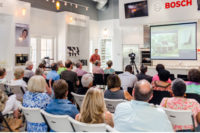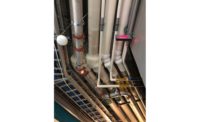Wyoming events center benefits from use of hybrid boiler and venting system.
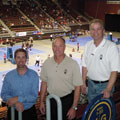
The Casper Events Center is Wyoming’s premier venue for scores of events, including concerts, conventions, culture and sports.
But a city-funded study concluded the facility, built in the early 1980s, was overdue for some major energy-efficiency improvements.
The budget for the boiler system upgrades got a jumpstart from state energy improvement grants and federal American Recovery and Reinvestment Act funds. The city hired Casper-based West Plains Engineering to design a new system that would achieve the required efficiency parameters and still keep the events center in full operation throughout the project.
“To go into an existing building and do these retrofits, they’re messy,” says Scott Isennock, P.E., West Plains’ lead mechanical engineer for the contract. “You have existing 30-year-old piping and a lot of hidden conditions. Plus, Wyoming has a short summer season so we had to complete the project in 3½ months. There were still events going on, including the College National Finals Rodeo, our marquee event. The contractors did a great job getting it done without affecting the schedule. There was no inconvenience to users coming to the center.”
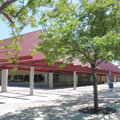
Going the hybrid route
West Plains turned to Lakewood, Colo.-based Engineered Products for recommendations on the ideal boiler and venting system configuration. The facility had been operating with two Scotch Marine boilers original to the building dating back to 1981. “Those boilers had to run and idle no matter what season it was,” Isennock says.
In that original configuration, a storage tank with a large 75 kw electric coil generated domestic hot water in the summer when the boilers drained down. “In my opinion, it wasn’t very energy efficient,” Isennock says. “They took great care of the equipment, but when the study was done, it highlighted things that went beyond service life and the boilers fell into that category.”
West Plains worked with Patterson-Kelley and Schebler Chimney to design a new hybrid system that utilizes four boilers – two condensing and two noncondensing vent Category IV models. This concept maximizes efficiency capabilities to the building load profile and the initial design parameters by expanding the outside air reset schedule capabilities.
“By taking full advantage of this expanded capability, we got the best of both worlds,” Isennock says. “We took advantage of the efficiency of the condensing boilers when we could, but we knew when it’s winter time in Wyoming, we needed the high-temperature boilers to heat the building. The building has events year-round. We wanted the condensing boilers to gain that energy advantage during shoulder seasons. The hybrid system worked out well for this facility.”
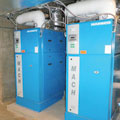
Airing it out
The next challenge the project team faced was routing the vent from the boiler room in the basement. The existing flue was interior and went up through the secondary mechanical room, through the concourse level with concessions and other public areas and terminated through a steep-pitched roof profile approximately 90 ft. above the event level floor.
The project team first looked at individually venting the boilers out the sidewall of the building, which was unacceptable since there are occupied areas above the mechanical room - namely outside walkways and doors - that could expose patrons to flue gases. A decision was made to follow the pathway of the existing flue, which created the need to combine the condensing and noncondensing boilers into one common vent.
This system configuration not only required joining various appliances, but on-demand situations where appliances are running at various firing rates or not at all. Varying internal flue gas temperature ranges and outside temperature changes due to the expanded outside air reset schedule also were concerns. These operating factors created some almost impossible-to-control conditions to maintain manufacturer-recommended exhaust outlet pressures on each appliance for proper performance and maximum efficiency.
Engineered Products consulted Schebler for a solution for the unique venting challenges. Schebler designed a complete venting system utilizing its Sequence Draft Control and the UL 1738-listed eVent product.
The SDC maintains consistent flue pressure or draft for hot water or steam appliances within the parameters of the manufacturers’ requirements, providing optimal system performance and safe evacuation of combustion gas. This is accomplished by individually monitoring and controlling outlet pressure at each appliance independent of the other appliances tied into the common breeching.
The venting had to be sized large enough for the worst-case scenario (12,000 MBH combined input of four boilers), yet still perform properly with one boiler firing at 600 MBH input in the middle of the summer with no adverse impact on condensing high-efficiency goals. The SDC system’s modulating dampers continually adjust to maintain the ideal programmed settings regardless of the firing rate, internal flue gas temperatures, external air temperatures, altitude, air density or the proximity of the lead operating boiler to the common vertical stack.
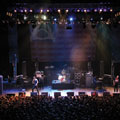
The system installed at Casper Events Center maintains ideal efficiencies by preventing excess draft conditions that can negatively impact the critical condensing dew-point temperature and not allow the corresponding efficiency gains to be achieved. The system also helps safeguard against improper fuel-to-air ratios during the combustion process. Improper combustion, whether through uncontrolled draft conditions or faulty startup, affects efficiencies, life cycle expectancy, and performance of boilers and /or water heaters.
“This was a big help to us because as engineers we don’t mix condensing and noncondensing flues together,” Isennock says. “Being able to use the hybrid system with a single vent stack didn’t follow tradition, but it worked great. This is a high-profile facility for our state. If anything were to go wrong, we’d make the six o’clock news in every small town in Wyoming.”
Isennock adds this was the first time his firm specified this type of solution. “We had talked about it for different jobs, but when you talked to owners, they opted to put in all condensing boilers,” he says. “They like having the same boilers. This was the first one where we had the best of both worlds. We have a system that can operate at the upper end of efficiencies and we can take advantage of the condensing boilers and save the cost with the noncondensing boilers when we don’t need them in the winter months.”
The eVent was able to meet the unique requirements for the hybrid system and enabled the sheet metal contractor to build the stack sections up from the boiler room and lift them from the roof using a hoist system. This was a significant benefit because of the challenging stack height, extreme roof pitch and limited access to the existing chase.
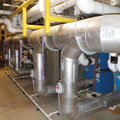
Monster job
The upgraded system was put to the ultimate test when the events center hosted a monster truck show in February. In order to safely evacuate the trucks’ gas exhausts, the dampers for all 18 air handlers in the building were opened to utilize 100% outside air. Even though the outdoor temperature was 35° F, the air coming off the air handlers was a comfortable 75° F.
“Thanks to the efficiency of the boilers coupled with the SDC-programmed settings and modulating damper performance capabilities, we were doing this with only three boilers,” Isennock says. “That was pretty much the extreme scenario.”
West Plains also worked to centralize maintenance for the facility. It installed two large Armstrong IVS pumps for the chillers. “All the pumps were getting old or had been rebuilt or replaced,” Isennock says. “Essentially, we converted both chilled and hot water systems to primary-secondary. The thought was to centralize maintenance. They had things going on all over the building. We put all the pumping back to the mechanical room. On a rough basis, we added up all the horsepower of all the pumps in the building and they now had less horsepower on the pumps and on the VAVs. We saw savings on pumping costs.”
In addition to improvements in energy usage, a side benefit the system upgrade brought to the table was the ability to make domestic hot water more efficiently. The facility had a 2,500-gal. storage tank that made DHW off the existing boiler system during the heating season. In the summer, a large electric element in the tank heated the water, resulting in a hefty line item on the center’s utility bill. Now, the condensing boilers (which feature Wilo pumps) make hot water using a heat exchange system, reducing storage needs down to 500 gal.
“We’re able to control our boilers based on the temperature outside,” Isennock says. “If it’s summertime and we don’t need heat, we just need hot water. We’re able to say, ‘Boiler No. 1, your priority is to make domestic hot water at the most efficient condition possible, running at 90-plus efficiency.’
“This adds up to significant savings on the facility’s electric bill. They’ve told us the savings they are realizing on their gas bill is helping reconcile their operating budget. The reduced bills are helping shift funds to help keep other options viable. It’s worked out really well.”
